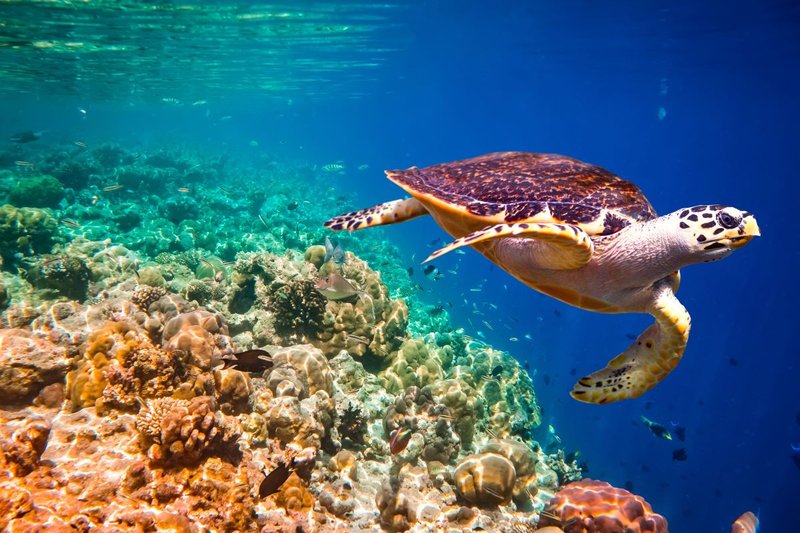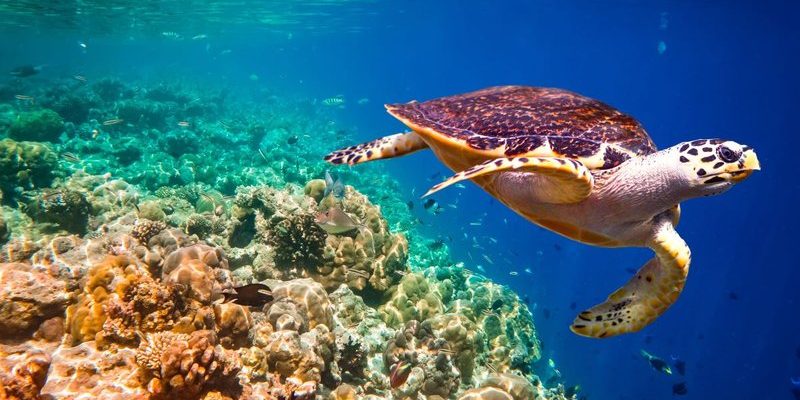
Hawksbill turtles are not just any turtles; they’re considered endangered and are vital for the health of coral reefs. They help maintain healthy reef ecosystems by grazing on sponges, which allows for coral growth. But with rising sea temperatures and sea levels, their existence hangs in the balance. Let me explain how climate change is impacting these stunning turtles and the underwater world they inhabit.
Understanding Hawksbill Turtles
Hawksbill turtles (Eretmochelys imbricata) are small to medium-sized sea turtles with a unique, pointed beak that resembles that of a hawk—hence their name. They typically weigh between 100 and 150 pounds and have a shell that is beautifully patterned with shades of orange, brown, and yellow. These turtles are primarily found in tropical coral reefs around the world.
Here’s the thing: they’re not just pretty to look at; they play a crucial role in marine ecosystems. By munching on sponges, hawksbill turtles help control sponge populations, allowing for more diverse coral growth. Without them, we might see a decrease in coral health and biodiversity, which can have a domino effect on other marine life.
Sadly, hawksbill turtles are currently classified as critically endangered. With their populations declining for decades, every little change in their environment can make a huge difference. Climate change is one of the most significant threats they face today.
Rising Sea Temperatures
One major way climate change affects hawksbill turtles is through rising sea temperatures. As global temperatures rise, ocean waters warm up, which can be detrimental to sea turtles. Warmer water temperatures can lead to coral bleaching, where corals expel the algae living in their tissues, resulting in a loss of color and a decline in health.
When corals die, the entire ecosystem suffers. Hawksbill turtles depend on thriving reefs full of sponges and other marine life. Without a healthy reef system, their food sources diminish, making it harder for them to survive. A warmer ocean can also affect the turtles directly. If they get too hot, it can impair their reproductive success, leading to fewer hatchlings.
You might be wondering, “How much of a temperature change can they handle?” Studies show that just a few degrees can significantly impact their survival and the health of their habitats. It’s a delicate balance, and even small shifts can have big consequences.
Sea Level Rise and Nesting Sites
Another major challenge for hawksbill turtles comes from rising sea levels. These turtles generally nest on sandy beaches, where females lay their eggs in the sand. As sea levels rise due to melting ice caps and thermal expansion of water, these beaches can be eroded or entirely submerged.
This loss of nesting sites is critical. Hawksbill turtles return to the same beaches where they were born to lay their eggs, but with less land available, the turtles may struggle to find safe places to nest. Not only does this decrease the number of new turtles hatching, but it also raises the risk of flooding for eggs that are laid in lower-lying areas.
In some places, conservationists have started to create artificial nesting sites to help. However, these efforts can only do so much. Protecting natural nesting habitats is crucial for the future of these turtles.
Changes in Ocean Currents
Climate change is also causing shifts in ocean currents, which can have ripple effects on hawksbill turtles. These currents are essential for navigating the ocean and finding food. If currents change, it can affect where the turtles can find their preferred meals, like sponges.
Imagine trying to find your favorite restaurant but the roads have changed—it’s frustrating, right? That’s similar to what hawksbill turtles face with shifting currents. They might have to swim farther or expend more energy, which can impact their overall health and well-being.
Moreover, altered currents can influence what marine life thrives in specific areas, potentially affecting the entire food web. This change means that hawksbill turtles will need to adapt to new challenges to find food and survive.
Pollution and Its Impact
Pollution is another grave issue exacerbated by climate change. Warmer temperatures can lead to increased algae blooms, often fueled by fertilizer runoff from land. These blooms can create dead zones in the ocean, where oxygen levels drop, making it hard for marine life to thrive.
Hawksbill turtles, while primarily herbivores, can accidentally ingest plastic or other debris mistaken for food, leading to serious health issues. Additionally, toxins from polluted waters can accumulate in their bodies, affecting reproduction and longevity.
It’s a tough reality. As we continue to contribute to environmental pollution through our actions, these turtles face even more obstacles. It’s like trying to run a marathon while carrying extra weight—you may not make it to the finish line.
Conservation Efforts for Hawksbill Turtles
Fortunately, there is hope. Numerous conservation organizations are working diligently to protect hawksbill turtles and their habitats. Efforts include beach cleanups, nesting site protection, and awareness campaigns aimed at reducing plastic use.
Community education is key. When locals understand the importance of hawksbill turtles, they often become more invested in preserving their environments. Engaging local fishermen to use more turtle-friendly fishing practices can also make a significant difference.
By supporting organizations dedicated to ocean conservation, we can help create a healthier world for these turtles. Every little action counts. Whether it’s reducing single-use plastics or participating in beach cleanups, we all have a role to play in ensuring these beautiful creatures continue to thrive.
Climate change poses a serious threat to hawksbill turtles, impacting everything from rising sea temperatures and nesting sites to pollution and ocean currents. While the challenges are significant, understanding these effects helps us realize the importance of protecting our oceans and the life within them.
We can make a positive impact through collective conservation efforts and choices in our daily lives. Hawksbill turtles deserve a chance to continue thriving in our oceans, just as they have for centuries. By being aware and taking action, we can help ensure that these magnificent creatures persist for generations to come, swimming gracefully through vibrant seas, just as they always have.

